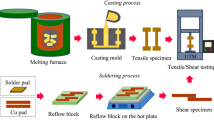Abstract
Eutectic lead-tin has been the solder of choice throughout the history of the electronics industry. Alternatives to this material are now being considered because of environmental concerns, as well as the strength and temperature limitations of eutectic lead-tin. Identifying and using these alternative materials poses significant challenges, many of which we believe can be addressed if one forms solder joints through liquid phase enhanced sintering. First, most alternative solder materials have significantly higher melting temperatures (than eutectic lead-tin), and their use would require the replacement of much of the manufacturing infrastructure. In this work joints with shear stresses approaching that of eutectic lead-tin solder were formed by sintering a eutectic tin-sliver solder paste (Tm=221°C) doped with 3 v/o eutectic Sn-Bi powder at 210°C for 30 min. Second, to date the industry has limited its consideration to eutectic or near-eutectic alloys because of the concern of forming cold solder joints. In this work joints have been prepared by sintering solder pastes with a wide thermal range at temperatures just above the solidus, where a small amount of liquid will form and therefore enhance the rate of sintering, which have shear strengths of 6 MPa or higher. These findings indicate that it may be worthwhile to investigate developing a sinterable solder paste, which can be used to prepare surface mount assemblies.
Similar content being viewed by others
References
The Lead-Free Solder Project: Final Report (City: National Center for Manufacturing Sciences, 1997).
D. Napp (Paper presented at the 1997 TMS Annual Meeting, Orlando, FL, 9–13 February 1997).
R.M. German, Powder Metallurgy Science, 2nd Edition (Princeton, NJ: Metal Powder Industries Federation, 1994).
W.D. Kingery, H.K. Bowen, and D.R. Uhlmann, Introduction to Ceramics, 2nd Edition (New York: Wiley & Sons, 1976).
M.A. Palmer, C.N. Alexander, and B. Nguyen, J. Electron. Mater. Ltrs. (to be published).
ASM Metals Handbook, 8th ed. (Metals Park, OH: ASM Int., 1978), p. 1071.
R.J.K. Wassink, Soldering in Electronics (Ayr, Scotland: Electrochemical Publications Limited, 1984), p. 12.
Author information
Authors and Affiliations
Rights and permissions
About this article
Cite this article
Palmer, M.A., Erdman, N.S. & McCall, D.A. Forming high temperature solder joints through liquid phase sintering of solder paste. J. Electron. Mater. 28, 1189–1193 (1999). https://doi.org/10.1007/s11664-999-0156-1
Received:
Accepted:
Issue Date:
DOI: https://doi.org/10.1007/s11664-999-0156-1




